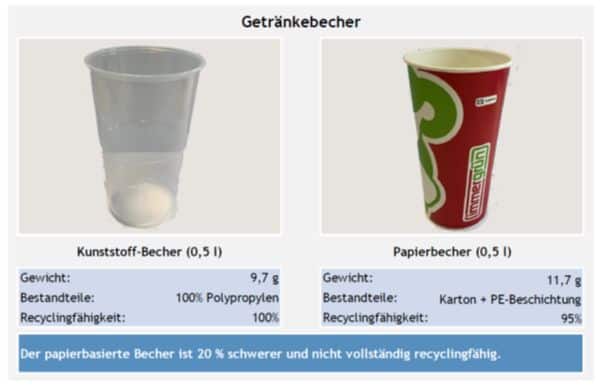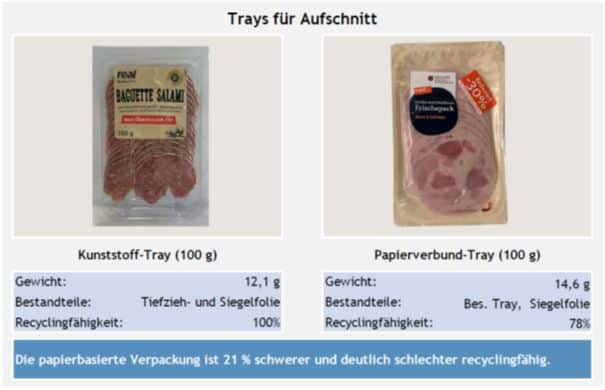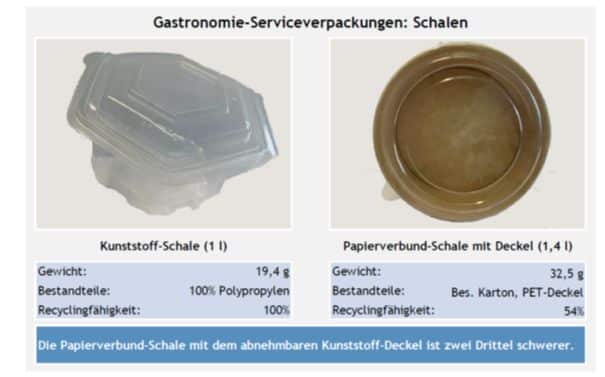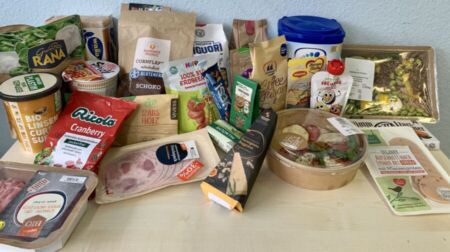Experts from industry, politics and science have been observing the trend towards the substitution of pure plastic packaging by paper composites – i.e. packaging made from a material mix of paper and plastic – for a long time. It is not uncommon for these to be advertised with “less plastic”, suggesting a special environmental friendliness to the consumer. This trend can be observed more frequently, especially for service packaging and higher-priced foods as well as organic items.
A study by the Society for Packaging Market Research (GVM) on behalf of the IK Industrievereinigung Kunststoffverpackungen confirms these concerns and comes to three main findings under the heading: Paper composites damage the circular economy.
Finding No. 1: Paper composites cause more packaging waste
Paper composites are already increasingly replacing pure plastic packaging and their share will continue to increase until 2025. The decisive factor is their good marketability in times of general plastic bashing. Paper composites require an average of 40 percent more material to pack the same amount of products. It is expected that by 2025 paper composites will generate a total of 25 thousand tons more waste.
Finding no. 2: Paper composites cause problems when recycling
As a rule, only the fiber content of the composite packaging is recyclable, which is usually over 70%. The only option left for the remaining plastic coating is energy recovery. In addition, the GVM states that the actual recycling of the fiber content is currently massively behind the theoretical recyclability and the increasing share of composites is increasingly causing problems when recycling waste paper. It is therefore particularly regrettable when easily recyclable plastic packaging is replaced, which is mostly the case.
Finding no. 3: Paper composites also replace plastic packaging that cannot be recycled, or only to a limited extent
In some cases, paper composites are also replacing plastic packaging which, as things stand today, is not or only partially recyclable . Due to the investments currently taking place in the circular economy, however, GVM assumes that the recyclability in the plastic packaging market will continue to improve significantly by 2025. Here, the substitution by paper composites competes with the optimization of recyclability in the plastic packaging market.
Sustainability strategies rely on recyclable plastic packaging and the use of recycled materials
 “As is so often the case, it is worth taking a second look, even behind headlines and advertising messages that appear green,” says Dr. Isabell Schmidt, IK managing director and expert for recycling management, confirms her skeptical attitude. “Replacing plastic packaging with paper composites is greenwashing. If the special properties of the plastic material are important for packaging, then paper fibers should be completely avoided and fully recyclable plastic packaging should be chosen.”
“As is so often the case, it is worth taking a second look, even behind headlines and advertising messages that appear green,” says Dr. Isabell Schmidt, IK managing director and expert for recycling management, confirms her skeptical attitude. “Replacing plastic packaging with paper composites is greenwashing. If the special properties of the plastic material are important for packaging, then paper fibers should be completely avoided and fully recyclable plastic packaging should be chosen.”
The interviews conducted by GVM show that many distributors want to go along this route. Many market participants express strong doubts about the ecological advantages of paper composites and want to increase the use of plastic recyclates in the interests of sustainability. The vast majority of those questioned do not want to replace their plastic packaging with paper composites.
About the Study
The study carried out by GVM analyzes the following questions: How strong is the effect of the substitution by paper composites expected by 2025? In which market segments does it take place? And what effects does it have on material consumption and the recyclability of the packaging?
All plastic-coated paper packaging with or without aluminum counts as paper composites, even if the paper content is over 95%. The substitution of plastic packaging by pure paper packaging and other materials as well as the trend towards unpackaged goods were not the subject of the study. The recyclability is measured according to the minimum standard of the Central Packaging Register.
Examples from the study:



Packaging 360 is a comprehensive knowledge sharing ecosystem for the Indian packaging industry. Our services include an online content platform to deliver news, insights and case studies; organising conferences seminars and customised training; Providing Bespoke Project Consulting, Market Research and Intelligence.







